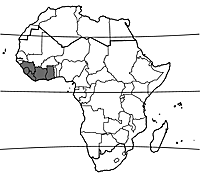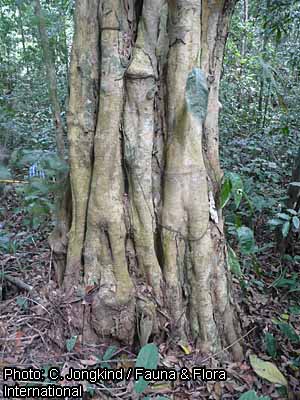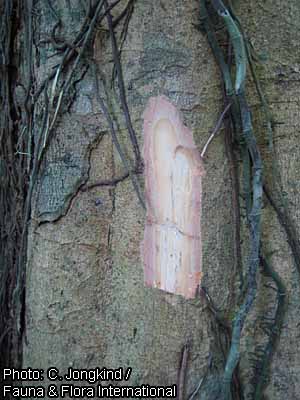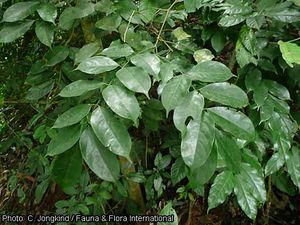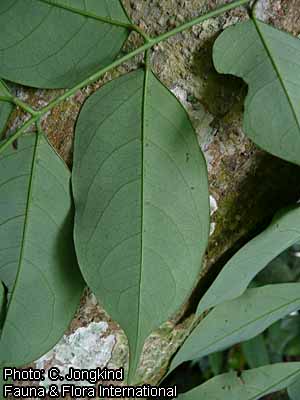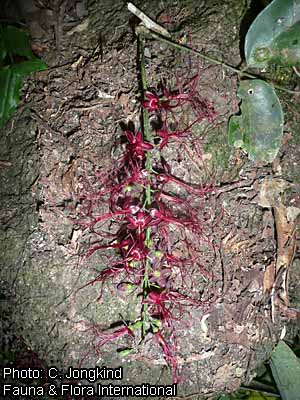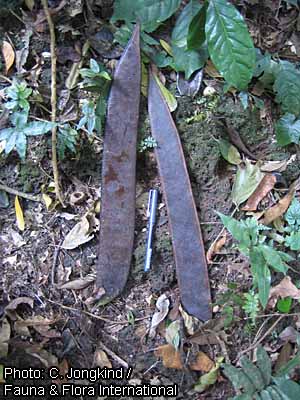Chidlowia sanguinea (PROTA)
Introduction |
| General importance | |
| Geographic coverage Africa | |
| Geographic coverage World | |
| Cereal / pulse | |
| Timber | |
| Food security | |
Chidlowia sanguinea Hoyle
- Protologue: Bull. Misc. Inform. Kew 1932(2): 101 (1932).
- Family: Caesalpiniaceae (Leguminosae - Caesalpinioideae)
Origin and geographic distribution
Chidlowia sanguinea is restricted to West Africa, where it occurs from Guinea and Sierra Leone to Ghana.
Uses
In Côte d’Ivoire the wood, known as ‘bala’, is locally used for joinery, stakes and rifle butts. It is suitable for heavy construction and probably occasionally used in building local houses, and is also suitable for sliced veneer. The seeds are reportedly eaten in Côte d’Ivoire.
Properties
The heartwood is dark greenish grey with a bronze tinge to dark brown and distinctly demarcated from the narrow yellowish white to pale greyish brown sapwood. The grain is interlocked, texture moderately fine and even. Radial surfaces show a ribbon figure. The wood is moderately heavy and hard. It is difficult to saw due to its hardness and the presence of interlocked grain. It is liable to splitting upon nailing.
The purine base triacanthine (chidlovine) has been isolated from roots, twigs and leaves.
Description
- Small to medium-sized tree up to 25(–30) m tall; bole often twisted, crooked, fluted and low-branching, up to 80(–100) cm in diameter, with many adventitious stems, occasionally with steep buttresses; bark surface irregularly flaky and scaly, greyish to brownish, with many lenticels, inner bark fibrous, soft, pink to reddish brown; crown widely spreading; twigs glabrous, with lenticels.
- Leaves alternate, paripinnately compound with 4–6 pairs of leaflets; stipules small, caducous; petiole up to 2.5 cm long, rachis up to 25 cm long; leaflets ovate to elliptical or obovate, 4–12 cm × 2–5 cm, acuminate at apex, leathery, glabrous.
- Inflorescence a slender, pendulous panicle up to 30 cm long, usually on older branches, many-flowered.
- Flowers bisexual, regular, 5-merous, deep red; pedicel slender, c. 3 mm long; calyx campanulate, c. 2 mm long, with very short teeth; petals free, ovate-elliptical to oblong-elliptical, 6–7 mm long, slightly fleshy; stamens 10, free, c. 2.5 cm long; ovary superior, slender, 4–5 mm long, with stipe c. 2.5 mm long, style slender, c. 2 cm long.
- Fruit a strap-shaped pod up to 60 cm × 6 cm, flattened, glabrous, glossy dark brown, dehiscing with 2 woody valves becoming spirally twisted, up to 15-seeded.
- Seeds nearly round, flattened, 2–2.5 cm in diameter, shining red-brown and finely pitted.
- Seedling with epigeal germination; hypocotyl c. 3 cm long, epicotyl 8–10 cm long; cotyledons thick and fleshy, rounded, c. 2.5 cm long; first 2 leaves opposite, pinnately compound with 2 pairs of leaflets.
Autres données botaniques
The flowers develop just after the appearance of new leaves, in Sierra Leone between February and May. It has been suggested that they are pollinated by birds. Fruits ripen about one year after flowering. They are explosively dehiscent, dispersing the seeds over some distance. The presence of nitrogen-fixing root nodules has been reported.
Chidlowia comprises a single species. Its affinity is still uncertain.
Ecology
Chidlowia sanguinea occurs in evergreen and moist semideciduous forest. It is usually found in the middle storey of primary forest, but occasionally also in secondary forest and gallery forest. It was very abundant in the upper basins of the Sassandra and Cavally rivers, locally occurring in nearly pure stands in the understorey. It also occurs in forest in the mountains, e.g. in the Mount Nimba region.
Management
The boles of large trees are often hollow, which diminishes the commercial value and may cause danger during felling.
Genetic resources
Chidlowia sanguinea is locally common, e.g. in western Côte d’Ivoire and in parts of Sierra Leone and Liberia. However, with the splitting-up of undisturbed forest in West Africa, it may be liable to genetic erosion.
Prospects
Chidlowia sanguinea will likely remain of no commercial importance because of its usually poorly shaped and short bole and its hard wood that is difficult to saw and work. Little is known about this species, and research is needed on phytochemistry and possible toxic effects of the seeds, which are reputedly edible.
Major references
- Burkill, H.M., 1995. The useful plants of West Tropical Africa. 2nd Edition. Volume 3, Families J–L. Royal Botanic Gardens, Kew, Richmond, United Kingdom. 857 pp.
- Hoyle, A.C., 1932. XI. - Chidlowia, a new tree genus of Caesalpiniaceae from West Tropical Africa. Bulletin of Miscellaneous Information 1932: 101–103.
- Kryn, J.M. & Fobes, E.W., 1959. The woods of Liberia. Report 2159. USDA Forest Service, Forest Products Laboratory, Madison, Wisconsin, United States. 147 pp.
- Savill, P.S. & Fox, J.E.D., 1967. Trees of Sierra Leone. Forest Department, Freetown, Sierra Leone. 316 pp.
- Tra Bi, F.H., 1997. Utilisations des plantes, par l’homme, dans les forêts classées du Haut-Sassandra et de Scio, en Côte d’Ivoire. Thèse pour obtenir le Doctorat de troisième cycle, Faculté des Sciences et Techniques, Université de Cocody, Abidjan, Côte d’Ivoire. 215 pp.
Other references
- Aubréville, A., 1959. La flore forestière de la Côte d’Ivoire. Deuxième édition révisée. Tome premier. Publication No 15. Centre Technique Forestier Tropical, Nogent-sur-Marne, France. 369 pp.
- Bouquet, A. & Debray, M., 1974. Plantes médicinales de la Côte d’Ivoire. Travaux et Documents No 32. ORSTOM, Paris, France. 231 pp.
- de la Mensbruge, G., 1966. La germination et les plantules des essences arborées de la forêt dense humide de la Côte d’Ivoire. Centre Technique Forestier Tropical, Nogent-sur-Marne, France. 389 pp.
- Hawthorne, W. & Jongkind, C., 2006. Woody plants of western African forests: a guide to the forest trees, shrubs and lianes from Senegal to Ghana. Kew Publishing, Royal Botanic Gardens, Kew, United Kingdom. 1023 pp.
- Irvine, F.R., 1961. Woody plants of Ghana, with special reference to their uses. Oxford University Press, London, United Kingdom. 868 pp.
- Keay, R.W.J., Hoyle, A.C. & Duvigneaud, P., 1958. Caesalpiniaceae. In: Keay, R.W.J. (Editor). Flora of West Tropical Africa. Volume 1, part 2. 2nd Edition. Crown Agents for Oversea Governments and Administrations, London, United Kingdom. pp. 439–484.
- Kunkel, G., 1965. The trees of Liberia. Field notes on the more important trees of the Liberian forests, and a field identification key. Report No 3 of the German Forestry Mission to Liberia. Bayerischer Landwirtschaftsverlag, München, Basel, Wien. 270 pp.
- Lewis, G., Schrire, B., MacKinder, B. & Lock, M., 2005. Legumes of the world. Royal Botanic Gardens, Kew, Richmond, United Kingdom. 577 pp.
- Normand, D., 1950. Atlas des bois de la Côte d’Ivoire. Tome 1. Centre Technique Forestier Tropical, Nogent-sur-Marne, France. 148 pp.
- Normand, D. & Paquis, J., 1976. Manuel d’identification des bois commerciaux. Tome 2. Afrique guinéo-congolaise. Centre Technique Forestier Tropical, Nogent-sur-Marne, France. 335 pp.
Author(s)
- R.H.M.J. Lemmens, PROTA Network Office Europe, Wageningen University, P.O. Box 341, 6700 AH Wageningen, Netherlands
Correct citation of this article
Lemmens, R.H.M.J., 2010. Chidlowia sanguinea Hoyle. [Internet] Record from PROTA4U. Lemmens, R.H.M.J., Louppe, D. & Oteng-Amoako, A.A. (Editors). PROTA (Plant Resources of Tropical Africa / Ressources végétales de l’Afrique tropicale), Wageningen, Netherlands.
Accessed 31 March 2025.
- See the Prota4U database.

